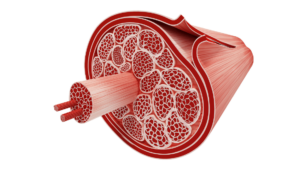What is Fascia?

Have you ever heard your massage therapist or even chiropractor use the word “myofascial?” Or simply “fascia?” If you wondered what they were talking about, here is a brief explanation of this incredible tissue.
Myo is the Greek word for “muscle,” and fascia is Latin for “band or sheet” of connective tissue. So myofascial simply means the continuous sheet of connective tissue in and around the muscles. As shown in the image below, each individual muscle fiber is wrapped in fascia, then bundled into a muscle fascicle, which is also covered in fascia; the fascicle is then bundled again into the entire bulk of the muscle (e.g. the biceps), which is also sheeted in more fascia. The muscle tapers into a tendon—a continuum of all the inner fascial layers—which finally connects to the bone.
“Fascia covers every structure of the body, creating a structural continuity that gives form and function to every tissue and organ.”[1] This helps us visualize how each bit of our body is literally connected to every other part through a seamless web of interlacing tissue. Although we have 650 different skeletal muscles in the body, because of the way fascia surrounds and joins all of these, it may be more accurate to think of them as pockets of muscle within the greater fascial system.
When fascia becomes restricted due to impact, injury, or repetitive strain, it dehydrates, hardens, inflames, and thickens.[2] A restriction in one part of the body (tight pectorals in the chest) can limit joint mobility (pulling the shoulders forward), causing an imbalance in other parts of the body (weak upper back muscles with knots) due to the way all muscles are linked by the fascial system.
Myofascial restrictions can be treated through manual therapies, most especially massage. When restrictions are released by a skilled therapist, the tissues are rehydrated, improving joint function and posture, reducing pain and inflammation. Releasing a restriction can require some time, not only in multiple visits but also in the moment during the session. What I mean by this is that the body guards its injuries, and any place that is inflamed, hardened, dehydrated, or immobilized will be protected. The body doesn’t like rapid intrusions upon these sensitive areas, and it often requires at least a few minutes of slow, patient work before the nervous system feels safe enough to release.
As a bodyworker, I have personally witnessed the best results from unhurried and deliberate work, especially through communication with my client. When they understand what I’m doing and why, they bring awareness to the sensations in their body, allowing it to unwind naturally and without force. With a greater understanding of how our bodies work, we can not only make educated choices about improving our health, but we can trust the signals of our bodies to communicate what we need every step of the way.

Emily Arnold
Author, Licensed Massage Therapist
Emily Arnold has a bachelor’s in Spanish and Intercultural Studies and attended the Costa Rica School of Massage Therapy where she became a Licensed Massage Therapist.
Photo Credit:
Canva by Buenosia Carol from Pexels
Canva by Science Photo Library
Resources:
[1] Bordoni B, Mahabadi N, Varacallo M. Anatomy, Fascia. [Updated 2019 Dec 1]. In: StatPearls [Internet]. Treasure Island (FL): StatPearls Publishing; 2020 Jan-. Available from: https://www.ncbi.nlm.nih.gov/books/NBK493232/
[2] Schleip, Robert. Fascia: the Tensional Network of the Human Body the Science and Clinical Applications in Manual and Movement Therapy. Churchill Livingstone / Elsevier, 2012.

